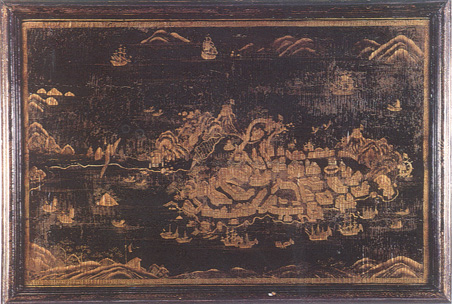 Cover of a chest with a bird's-eye view of Macao. Chinese work commissioned by Portuguese. Eighteenth century.
Gilt brushwork on lacquered wood. 50.0 cm x 87.0 cm -- detail.
Alpoim Calvão Collection, Cascais.
Cover of a chest with a bird's-eye view of Macao. Chinese work commissioned by Portuguese. Eighteenth century.
Gilt brushwork on lacquered wood. 50.0 cm x 87.0 cm -- detail.
Alpoim Calvão Collection, Cascais.
Fan Shouyi, commonly called Louis or Luigi Fan after his sojourn in Europe, is a strangely neglected figure in Sino-European relations. He was the author of what appears to be the only surviving account, by a Chinese visitor to Europe before the nineteenth century, of their experiences in Europe. 1 As an informant of the Kangxi Emperor on the divisions of Christendom and the political impotence of the Pope, he played a crucial if unappreciated role in the Chinese Rites Controversy which fatally divided the European missionaries in China. And, as shall be shown in this brief commentary, his impressions of Macao and even more the official Chinese documentation relating to his passing through Macao on his way through this port shed a very interesting light on Chinese relations with Macao in the early eighteenth century.
Fan Shouyi was born in Pingyang, 2 Shanxi Province, on the 13th of June 1682 and at an early age became attached as companion, some sources say catechist others servant, to a missionary in Shanxi, the Italian Jesuit Antonio Provana. He must have accompanied Provana to Beijing, in August 1705, and seems to have been registered as a tianwen sheng (student of mathematics in the Bureau of Astronomy)3 which, together with his later admission to the Society of Jesus indicates a degree of formal education. When Provana was appointed by the Kangxi Emperor as Embassador to the Pope in his dispute with the Papal Legate, Charles Maillard de Tournon, over the Rites issue, Fan accompanied him. Once in Europe, he was to apply for admission to the Society of Jesus but there is no trace of such an intention in the contemporary documentation relating to his departure for Europe. Rather, he is said to have been sent as Chinese language secretary to Provana4 and was introduced by Provana himself on his arrival in Genoa, in a letter to the Jesuit General as a Chinese witness in the Rites Controversy. 5
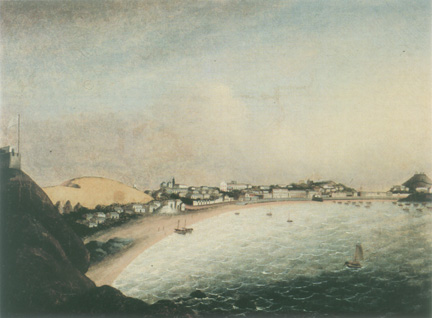 Landscape view of Macao. Unknown artist. Macanese work from the nineteenth century.
Inscribed: "MACAU". Oil on canvas. 45.5 cm x 58.5 cm.
Arquivo Histórico Ultramarino, Lisbon, inv. no. 3425.
Landscape view of Macao. Unknown artist. Macanese work from the nineteenth century.
Inscribed: "MACAU". Oil on canvas. 45.5 cm x 58.5 cm.
Arquivo Histórico Ultramarino, Lisbon, inv. no. 3425.
In October 1707. they left Beijing and on the 14th of January 1708, embarked in Macao for Europe on the Bom Jesus de Mazagao das Brotas, 6 taking the unusual route via Batavia and Bahia to Lisbon and arriving in Rome, through Genoa, in February 1709. To travel to Europe from Macao via Batavia was unusual but possible in this period of comparative peace between Portugal and Holland. On the other hand, there was a strict prohibition on Macao ships calling in Brazil although it was quite common at this period for Portuguese ships from India to take this route. The Bahia port register notes the Bom Jesus as having called in for "repairs"7 which was probably a subterfuge.
Fan introduces his account of the voyage in the Shen jian lu (A Record of What I Saw) as follows:
"My family name is Fan, my personal name Shouyi, and I was born in Pingyang, to the West of Long Mountain, and brought up to revere the true Lord and serve him constantly. If I remember rightly it was the end of Winter, 1707, when the eminent Western scholar Provana was ordered on an Embassy to the West with me as his companion. We travelled across mountains and rivers, through Cities and regions, and moreover experienced difficulties and dangers from wind and wave, greater by far than I can enumerate. And how could one who has merely heard about it, but not seen it, understand?"8
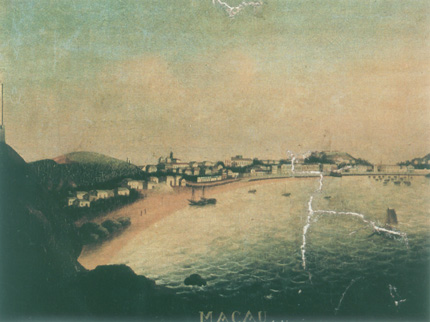 Landscape view of Macao. Unknown artist. Macanese work from the nineteenth century.
Oil on canvas. 44.6 cm x 58.7 cm.
Private Collection., Lisbon.
Landscape view of Macao. Unknown artist. Macanese work from the nineteenth century.
Oil on canvas. 44.6 cm x 58.7 cm.
Private Collection., Lisbon.
He then goes on to describe the circumstances of writing this account on his return to China, a subject we shall return to later. For the moment however it is worth noting that the report was for the eyes of the Emperor and presumably represents the Emperor's interests. Hence the emphasis on geography, fleets and fortifications, commerce, science and technology, all matters emphasised in their accounts of Europe by his Jesuit teachers. Fan was confirming their veracity and indirectly the authority of Christianity and at the same time acting as a loyal Chinese citizen. And en route, as in Europe, it is the Portuguese King and the Pope, the twin patrons of the Jesuit missionaries, who come in for most favourable attention and their domains which are given the most fulsome praise. The travel account itself begins:
"We left Aomen [Macao], embarking on a great warship, loaded with goods and supplies, effortlessly sailing over the boundless Oceans, heading Southwest day and night. We sailed for two months, passing by various Countries such as Palagua, 9 Manila, 10 Malacca, Bangka, Sumatra, and many islands. The climate was getting hotter, the vegetation thick and luxuriant, the population dense, the produce fragrant: black pepper, dried skins, sappan wood, sandalwood; and fruits that grow throughout the year. The appearance of the people is dark in skin colour, and they are of peaceful disposition, or at least most are."
Then comes the description of Batavia with its emphasis on the City as a centre for commerce and the contrast between its layout and that of a Chinese City:
"In the Kingdom of Malacca11 there is a great City called Batavia, a place where the merchants of Holland gather, where there are more than two-hundred Ocean-going vessels sheltering within the harbour, and foot soldiers and cavalry guard the fortifications, night and day, without interruption. Inside the walls are streets and suburbs, divided by a river running through the middle and trees line the river bank. In all the shops, great and small, there are Western and Chinese goods of all sorts and there is nothing you cannot find here. The houses of the officials, complete with gardens, are built outside the City."12
Whether driven by storms or unfavourable winds, or intentionally, the Bom Jesus, after rounding the Cape of Good Hope, then took the zig-zag cross-Atlantic route to Lisbon via Bahia, in Brazil. Bahia, like Batavia, is depicted as a great commercial centre, but also, significantly, as a centre of Culture and learning. Note also the central place given to the Jesuits:
"We sailed for about three or four months, and after sighting the Dalang mountains, 13 because the ship was short of water, we put into the City of Bahia, in America. Outside the City was a bay with a calm water anchorage in which were more than a hundred great ships, especially very tall, large and thick-sided warships mounted with big cannons. The place is very fertile, the climate is pleasant, the weather is never cold; it produces balsa wood, 14 knife sharpening oil, 15 snuff, cassia bark, white sugar, abundant grain, sheep and cattle, gold as well as silver plentiful and easy to obtain. Portugal occupies this place which adjoins the sea. In the City are constructed a Catholic Church, the Church of All Saints, and a school for religious instruction, all both tall and strong; and there are all kinds of tools which everyone uses in common in their work. There is a University and a secondary school, each well constructed and beautiful and much frequented; the students are intelligent and perspicacious. The administrators therein are like former high officials, supervising the completion of exercises in civil and military affairs. There is a Jesuit House on the hilltop with more than a hundred students of religion. The scholars have everything they need to construct machines which require only one man on the outside to work them, and immediately they pull something up, such is their ingenuity. Since this region has no stone which could be used to construct large buildings, they send to Europe for ready-made stone materials, and use them to complete the building. There is one edifice, very large, in which are stored precious objects, and in the upper storey there is a library, with fifty or sixty shelves to house the books which must number several tens of thousands of volumes, and this is greatly to the credit of the Municipality of Bahia."16
Fan then describes their arrival in Lisbon in September 1708:
"We entered the harbour. There were many forts built for defence; all sea traffic has to moor near them and the officials of the garrison have orders to inspect and report whether they are permitted to enter. After sailing five li we saw the City walls surrounded by a large river flowing from the interior into the sea, and there were three or four hundred Ocean-going vessels anchored there. That day we disembarked, and went to stay at the Jesuit College. Fr. Provana17 looked carefully about him, in his usual attentive way, and showed me around,pointing out the metalwork all in silver."
Fan then gives a rapturous account of the marvels of the City:
"We saw the sights, as magnificent as can be seen anywhere, an exceedingly rich City, lacking nothing one might need. There are fountains in abundance; the buildings are of three or four storeys, not one, and the palaces of the nobility and the King are extremely beautiful, as are the Catholic Churches, the Churches dedicated to Mary and the Saints, completely constructed of stone and skilfully erected, with votive statues covered with gold and silver. There are numerous religious Colleges, and the students in each generally number a hundred. The schools are divided into the following classes: four classes for primary school, two for the middle school, and three for the highest. Furthermore there are several charitable Institutions with many inmates, and many splendid gardens."18
For Fan Shouyi, the highlight of their time in Lisbon was their audience with the young Portuguese King, João V. Here is his description of their meetings with the King and of the royal palace:
"On the third day the King called us to an audience. His palace is much more beautiful than any I had ever seen before. Outside there is a detachment of guards, and inside a multitude of servants. The King had his three younger brothers with him. He is nearly twenty years old, of an affable and modest demeanour. Another day we saw the King again and he gave orders to permit us to wander around the palace. We saw the red curtains covering the walls, some of brocade, some embroidered, or painted with designs. In Summer they use porcelain shutters to keep out the light. There are glass windows, embroidered felt cushions, gold encrusted stools and crystal tables dazzling people's eyes. Inside the palace there is also a Church, and the King goes there frequently to worship, as do the high officials, to hear mass. The next day, the King and Queen went to Church to thank the Lord. Their carriage was so beautifully decorated that it is beyond description. The King's Court all came to pay their respects to him, and when the King stood up, the officials at the side all bowed to him three times and approaching him kissing his hand and either inquired of his health or retired, and so it went on to the end."19
Notice again the mixture of items intended to attract Kangxi's attention: palace etiquette and palace décor, gardens and public buildings, laced with references to Christianity and its civilising and educational functions. And similarly, the narration of their forward journey after four months in Portugal continues with descriptions of the Mediterranean countries and Cities visited, the palaces and people, Churches and fortifications, until they arrive in Rome. The treatment of Rome itself is even more full of superlatives than that of Lisbon.
"We came to the Pope's Kingdom. His capital is called Rome, and has been a major capital City since ancient times. The circumference of its walls is one hundred li and the Pope lives there. The City gates are not closed at night. Some two days after we arrived we had an audience with the Pope, and had an excellent reception. He permitted us to inspect all the buildings inside and outside the palace, many thousands of them, huge and extravagant, so it is difficult to adequately describe them."20
For reasons that can only be conjecture, 21 Fan does not describe the Papal audience, but proceeds with a classic account of the marvels of Rome, its gardens, fountains, bridges and buildings.
The rest of this short work (only ten pages in the printed edition) is devoted to further travel in Italy. It reads like a continuous traveller's tale, but we know from Jesuit records that these Italian journeys were associated with his Jesuit training: novitiate at San Andrea al Quirinale, in Rome, from late 1709, studying Latin, in Milan, Theology, in Turin and ordination as a priest in 1717. The narrative includes descriptions of the major Italian Cities including Naples, Milan, Modena, Parma and Turin, not omitting the Holy House of Loreto and the 'miracle' of the liquification of the blood of St. Januarius. I have often wished that some record of the reaction of the Emperor and his officials had survived.
Provana meanwhile was unsuccessfully pursuing his business in Rome and elsewhere on behalf of the Chinese Jesuits and the Emperor. Soon after the ordination of Fan Shouyi they reembarked from Livorno for Lisbon and thence, in May 1719, for China on the Francisco Xavier. Provana died at sea off the Cape of Good Hope and Fan seems to have assumed the role not only of protector of his possessions and remains but of executor of what remained of his Embassy. At least it was in that guise that he presented himself to the Chinese officials, to the consternation of the European Jesuits in China who hardly knew him and mistrusted this new Chinese colleague appearing at a most delicate time, when a new Papal Embassy was imminent. 22 In July 1720, they were even more distressed when Fan was removed from their control soon after landing in Macao and whisked off to the North where, on the 11th of October 1720, he had audience with the Emperor. It is that audience with which the Shen jian lu ends but, to our frustration, no details are given and none survives elsewhere. The work itself, however, was most likely produced for the eyes of the Emperor as a follow-up to that interview. All Fan says in the Preface of the circumstances of the writing of the work is that it was produced in "the first month of the Summer of 1721 and humbly presented to the princes, dukes and high officials".23
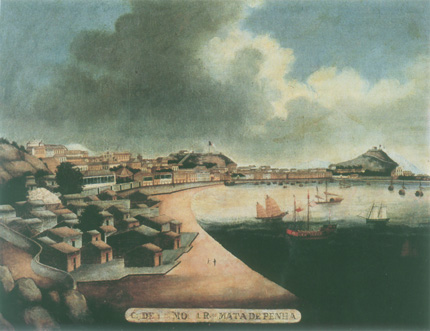 Landscape view of Macao. Unknown artist. Macanese work from the first half of the nineteenth century.
Inscribed: "C. DE... MO... R. MATA DE PENHA". Oil on canvas. 46.0 cm x 61.5 cm.
Francisco Hipólito Raposo Collection, Lisbon.
Landscape view of Macao. Unknown artist. Macanese work from the first half of the nineteenth century.
Inscribed: "C. DE... MO... R. MATA DE PENHA". Oil on canvas. 46.0 cm x 61.5 cm.
Francisco Hipólito Raposo Collection, Lisbon.
Why was an unknown Chinese of such interest to the Emperor and his officials? Initially it was not because of his unique first-hand knowledge of Europe although I suspect this may have been behind the Emperor's request for a written record. The main reason was that Fan's return to China represented the first direct news of the fate of Kangxi's many Jesuit Ambassadors in the Rites case. António Barros and Antoine de Beauvollier, who had left Guangzhou in January 1707; José Ramon Arxó and François Noël, who had travelled with Provana and Fan: none had returned. In fact Barros and Beauvollier had been shipwrecked before reaching their destination, in January 1708 off the Portuguese coast; Arxó had died in Spain in 1711; Noël who, with Kaspar Castner, had made an earlier round-trip to Europe (1702-1706) as a Procurator for the Jesuit Vice-Provincial of China and the Province of Japan had been denied permission to return. And Provana, as we know, had also died at sea. 24 So Fan alone was left to tell the tale.
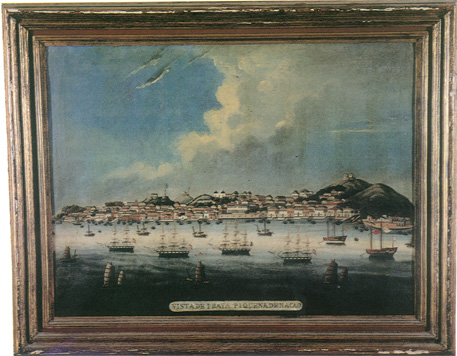 Landscape view of Macao. Unknown artist. Macanese work from the first half of the nineteenth century.
Inscribed: "VISTA DE PRAYA PIQUENA". Oil on canvas. 46.0 cm x 61.5 cm.
Francisco Hipólito Raposo Collection, Lisbon.
Landscape view of Macao. Unknown artist. Macanese work from the first half of the nineteenth century.
Inscribed: "VISTA DE PRAYA PIQUENA". Oil on canvas. 46.0 cm x 61.5 cm.
Francisco Hipólito Raposo Collection, Lisbon.
The Emperor's anxiety about his missing Ambassadors is strikingly attested to in a curious document which has survived in several examples, the so called Red Manifesto issued by the Kangxi Emperor, on the 31 st of October 1716, and printed in Manchu, Chinese and Latin, 25 authenticating the missions of Barros, Beauvollier, Provana and Arxó. 26 The Emperor ordered that copies be distributed to all Westerners arriving in Guangdong so that they might take it back to Europe. Why the Emperor's concern? Not only had his Ambassadors not returned, but, he says in the Red Manifesto, "confusing messages have arrived".27 These may well have included the news, later confirmed by Fan Shouyi in his initial report to the Court officials in Guangzhou, 28 that Provana had been prevented from returning to China because his credentials were suspect. Kangxi states:
"It is certain that, only after the men we commissioned have returned and everything is cleared up, credence can be placed in anything. Should the men we commissioned not return, authentic evidence will still be lacking, and no matter what letters may be had, credence positively cannot be given to them."29
There are a series of Edicts issued by Kangxi to his officials in Guangdong and Guangxi, beginning even before the Red Manifesto, ordering inquiries to be made of all ships arriving from Europe about the fate of his envoys. The earliest is dated the 5th of November 1710 and orders various officials down to the level of Fan Shichong, Superintendant of Guangzhou, to report any news of them. 30
An invaluable collection of manuscripts, now in the Ricci Institute for Chinese-Western Cultural History, at the University of San Francisco, 31 gives us an indication of the chain of command which would have been followed in the affair. One set of documents32 deals with events earlier the same year, 1710, when a group of missionaries under the Lazarist Teodorico Pedrini, arrived in Macao, unauthorized, from Manila. The Macao authorities attempted to expel them but the Papal Legate, Charles Maillard de Toumon, then under House arrest in Macao, intervened. The Viceroy of the Two Guangs, Zhao Hongcan, instructed his Treasurer to investigate and report. In turn he passed on the order to the Military Commander of Xiangshan county who gave it to the Commandant of the Macao garrison, Chen Zongde, to implement. Magistrate Pang, of Xiangshan, eventually reported back along the chain and the Emperor ordered the new missionaries with special skills, Pedrini as a musician, Guillaume Bonjour as a mathematician and Matteo Ripa as an artist, to be sent on to Beijing.
Similarly, in the decade that followed until Fan's unannounced arrival, the Guangzhou officials, no doubt following notice from Macao, regularly reported to Beijing on newly arrived ships and the people and news they brought. In the year before Fan's return, for example, on the 25th of July 1718, Yang Lin, the Governor-General of the Two Guangs, reported on several European ships that had arrived in the previous two months, and amongst other news, that Provana was still in Italy, had received the Red Manifesto, and was expected to return soon. The Emperor added his usual laconic "Noted" in red ink. 33
Next month Yang Lin reported that after the arrival of another Western ship, the Jesuit Giovanni Laureati had informed him that the Pope had received the Red Manifesto, had called "Ambassador" Provana to his Court in Rome, and that Provana's return could be expected soon. He added that there were many Westerners in Macao and that he would report any new arrivals of interest. This time Kangxi's annotation is longer: "Noted. If any of the Westerners who arrive are experienced scholars or skilled technicians, you must take care to send them on to the Court." 34
On the 18th of July 1719, Governor-General Yang Lin and Governor Yang Shouren, of Guangdong, reported that Laureati had received a letter by the latest ship announcing that Provana had left Rome for Portugal, at the end of the previous year, preparatory to returning to China. 35 Yang Lin again reported, on the 15th of September 1719, that there was no news of Provana from either Guangdong or Guangxi. 36
Then, on the 17th of July 1720, the two Yangs reported37 to Beijing that on the 5th of July the Xiangshan Military Commander, Chen Liangbi, had announced the arrival at Macao of a Portuguese ship; that he asked news of Provana, and was told by the captain that he had died at sea, but that there was on board "a certain disciple called Fan Shouyi, a Chinese, who had accompanied Provana to Europe, and was now returning, a follower of his religion". The ship was berthed in Macao harbour and Fan interrogated:
"He said he was originally from Pingyang, in Shanxi, had been in the service of Provana from his youth and so accompanied him in 1707. In 1708, they travelled together to Europe and when they arrived in Europe had an interview with the Pope in his capital City, travelled around for several years and in various countries, and after some years, in 1718, having been despatched by various Western ships, the Red Manifesto arrived on an English warship and was seen by the Pope who ordered Provana to return. In May 1719, they were ordered to board a Western ship, and given seven cases of various goods and one bird-rifle as gifts. Provana, however, sickened and died, on the 15th of March1720, near Dahen Mountain, in the Indian Ocean. After his death I, the aforementioned Fan Shouyi, continued on and am now resident in the Catholic Church, in Guangzhou."38
In the light of this history, it is not surprising that the local officials despatched Fan immediately to Guangzhou on the 21st of July, as they reported on the 25th of July, 39 and it was here, apparently, that he gave a deposition relating to the Rites Controversy issue and the interview he and Provana had with the Pope. 40 On the 5th of August, he set out for Beijing and his Imperial audience, in Jehol.
Fan Shouyi's later career was that of a hardworking Chinese priest in difficult times. In the mid 1720s and 1736, he carried out dangerous missions such as visits to the exiled Manchu Christian Sunu family and pastoral work in Hebei and Liaodong. He died in Beijing, in 1753, and his tombstone, in Latin and Chinese, in the old Jesuit cemetery of Chala reads:
"Fr. Louis Fan, Former Coadjutor of the Society of Jesus, Chinese from Shanxi Province. Entered the Society, in Rome, in 1709. On his return to China, he spent thirty-three years on the mission and had forty-four years in the Society. Unwearied worker and vigilantly religious. Died in Beijing, on the 28th of February, in his seventy-first year."41
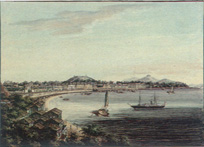
Landscape view of Macao. Unknown artist. Cantonese work from the nineteenth century.
Egg tempera on paper. 20.0 cm x 28.0 cm.
Arquivo Histórico Ultramarino, Lisbon.
All that is missing is "author of the earliest surviving first-hand account of Europe by a Chinese".
NOTES
1 FAN Shouyi, Shen jian lu, in: Ed. FANG Hao, "Zhong xi jiaotung shi", 5 vols., Taipei, Huagang, 1977 [1st. ed., Taipei, 1953], vol. 4, pp. 186-195 - For a complete version of the manuscript. This version was discovered by the Chinese bibliographer Wang Zhongmin in the Biblioteca Vittorio Emmanuele, in Rome. FAN Shouyi, Shen jian lu, in: Ed. ROSSO, Antonio Sisto, "Apostolic Legations to China of the Eighteenth Century", South Pasadena, P. D. & lone Perkins, 1948, doc. 20, pp. 332-334 - For a shorter version of the manuscript, possibly prepared for the officials in Guangzhou who interrogated him. This version is in the Bibliothèque Nationale, in Paris.
2 PLANCHET, Jean-Marie, Le cimitière et les oeuvres catholiques de Chala, Beijing, Imprimerie des Lazaristes, 1928, p.186 - His tombstone has Jiangzhou (modern Xinjiang) as his place of origin. But the preface to the Shen Jian Lu says explicitly that he was born in Pingyang (modern Linfen) fifty odd kilometres to the North of Xinjiang. The explanation is probably that his family was from Xinjiang but resident in Pingyang, hence the Jiangzhou ren of the headstone.
3 ARSI, Jap.-Sin., 178, fol. 362, "A letter from the Jesuit Visitor, Giovanni Laureati (from Guangzhou) to the Jesuits, in Beijing, 18 July 1720" - The text describes him as having been a tianwen sheng, which is glossed as a junior clerk in the bureau, but this title was used, at least later in the century, to secure gentry status and hence legal protection for Chinese priests. It may have been no more than a formality in Fan's case.
4 LAUREATI, Giovanni, op. cit., fol. 362ro.
5 ARSI: Fondo Gesuitico, 730.9, "Letter, 2 February 1709"
6 LAPA, J. O. do Amaral, A Bahia e a carreira da India, São Paulo, Companhia Editora Nacional, 1968, p.366 -This ship is listed as arriving in the port out of Macao in June 1708, the only such until 1781.
7 Idem.
8 FANG Hao, op. cit., p. 187.
9 BA-LA-KE-YA - Palagua, which is the old name for modern Palawan.
10 MO-ER-NAI-YA - Manila. The identification is problematic since the normal Chinese name for the region was Lu-song (Luzon); but this may well be Fan's recollection of the name as pronounced by Provana or a Portuguese sailor.
11 BOXER, Charles R., The Dutch Seaborne Empire, 1600-1800, Harmondsworth, Penguin, 1973, p.211 -The area surrounding Jakarta, itself renamed Batavia by the Dutch, had come to be known as 'New Malacca' because of its strategic importance.
12 FANG Hao, op. cit., pp. 187-188.
13 Unidentified. Possibly the Cape of Good Hope, but more likely the island of Trinidad or some other mid Atlantic island.
14 Literally "BA-ER-SA wood fragrance".
15 Or "DAO-SHANG" oil?
16 FANG Hao, op. cit., p.188.
17 Referred to, as in the introduction, as "the illustrious scholar".
18 FANG Hao, op. cit., pp. 188-189.
19 Ibidem., p.189.
20 Ibidem., p.190.
21 RULE, Paul, Louis Fan Shouyi: a Missing Link in the Chinese Rites Controversy, in: "Proceedings of the VIIéme Colloque Internationale de Sinologie, Chantilly 1992", Taipei-Paris-San Francisco, Ricci Institute, [forth-coming] - Where I argue that Fan had, probably by the time he wrote this account, been warned by his Jesuit Superiors against further polemics in the Rites Controversy cause.
22 This was the Embassy of Carlo Ambrogio Mezzabarba who, following some months in the wake of Provana and Fan, was and received by the Emperor, in December 1720.
23 FANG Hao, op. cit., p.187.
24 RULE, Paul, Towards a History of the Chinese Rites Controversy, in: "International Symposium on the Chinese Rites Controversy", San Francisco, 1992, pp. 258-262 [to be published in the Monumenta Serica Monograph Series] - For a more full account of the fate of these Ambassadors.
25 ROSSO, Antonio Sisto, op. cit., doc. 13, pp. 307-309 -For an English translation. CHEN Yuan, Kangxi yu Loma shijie guanxi wenshu yingyin ben, Beiping, Gugong Bowu, 1932, doc. 9 - For a reproduction of the Chinese draft, with the Emperor's own corrections.
26 DEHERGNE, J., S. J., Répertoire des Jésuites de Chine de 1552 à 1800, Roma, Institutum Historicum Societatis Iesu, 1973, p.186 - Note that Noël is not mentioned which may mean that he was not"envoyé par K'ang Hi", but that his second mission was again as Procurator for the Jesuit Mission.
27 ROSSO, Antonio Sisto, op. cit., p.309.
28 Ibidem., pp. 133-134.
29 Ibidem., p.309.
30 Eds. Zhongguo di lishi dangan guan, Kangxi zhao Hanwen zhupi zuozhe huibian, Beijing, Danmgan chuban she, 1984-85, vol. 3, doc. 736, pp. 68-72.
31 They were part of the collection of Philip Robinson, sold by Sotheby's, London, on the 22nd of November 1988 Sale: The Library of Philip Robinson. Part II. The Chinese Collection, and most appear to have belonged to Ilarione Sala, one of Maillard de Tournon's staff.
32 Sotheby's, London, the 22nd of November 1988 Sale: The Library of Philip Robinson. Part II. The Chinese Collection, lot 20, nos 9-14.
33 Eds. Zhongguo di lishi dangan guan, op. cit., doc. 2640, vol. 8, p. 198.
34 Ibidem., doc. 2669, vol. 8, p. 268 - Dated 23 August 1718.
35 Ibidem., doc. 2779, vol. 8, p. 506.
36 Ibidem., doc. 2816, vol. 8, pp. 588-589.
37 Ibidem., doc. 2873, vol. 8, pp. 701-702.
38 Ibidem., doc. 2873, vol. 8, p. 702.
39 Ibidem., doc. 2877, vol. 8, p. 711.
40 ROSSO, Antonio Sisto, op. cit., doc. 20, pp. 331-334.
41 PLANCHET, Jean-Marie, op. cit., p. 186.
* Historian and researcher on the Christian Missions in China. Lecturer of History and Religious Studies in La Trobe University, Melbourne. Author of Kung-Tzu or Confucius: the Jesuit interpretation of Confucianism in China and Louis Fan Shouyi, a Missing Link in the Chinese Rites Controversy. Currently working on the annotated translation of the works of Fan Shen Jiau Lu and on an unpublished collection of writings by José Maria Braga.
start p. 249
end p.